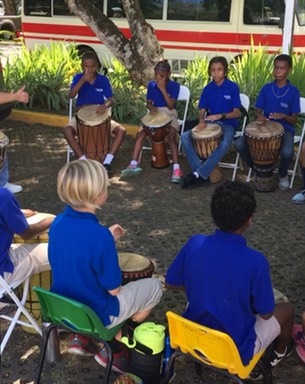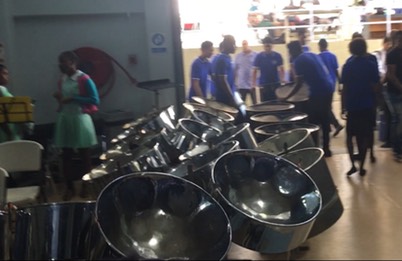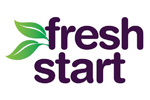We are just over a week into the Trinidad
and Tobago Music Festival and Queen’s Hall is a hive of positive energy. I
visited on Thursday to pick up competitor’s cards for my guitar students and
was pleasantly greeted by African drumming ensembles scattered across the
courtyard preparing for their performances. They were joyfully practicing,
orderly and obviously proud of the products they had been working so hard on
for the past months. As I approached the loading area at the back of Queen’s
Hall, I noticed steel band ensembles setting up, many kids with anxious faces.

At a time when the symbolic movie Black
Panther has triggered widespread displays of pride on and celebration of African heritage, I was
reminded of one of the benefits of the arts, especially the ‘traditional arts’.
It harnesses a positive sense of identity. Studies have found that youth
involved in traditional arts, in addition to being psychologically better off
than those who did none, had better positive connections to their families and
communities. These youth are better prepared to be well-adapted and productive
members of society. (https://medicalxpress.com/news/2009-06-arts-good-psyche.html#nRlv)
It’s in this light that I felt the need to highlight some of the categories of T&T’s Music Festival (besides pan) that celebrated our identity and made it unique to the rest of the world.
N.B. All definitions were taken directly from the Music Festival Syllabus, which can be found on their website. (http://www.ttmusicfestival.org)
Calypso
“Developed during the 19th century with roots in Trinidad’s Carnival, it grew out of the various styles of Carnival music, including ribald songs, traditional drumming, social and political commentary and stick-fighting songs, which was originally sung in French Patois and by the turn of the century, sung in English. These tunes were originally sung by a “Chantuelle”, a singer who performed in Carnival “Tents” and traditionally led carnival masquerade bands. In the late 1920’s calypso evolved into a more ballad like style of political and social commentary. By the late 1970’s a completely new style, the “Soca”, (and offshoot of Calypso) was created by Lord Shorty, Shadow and others. These artists added a range of rhythmic influences from Indian music to R&B. This music has evolved side by side with the calypso and is less lyrically oriented. Soca has become almost exclusively the Road March – which is essentially music for dancing in our “street Carnival”“
Parang
“The body of Music (traditionally sung in Spanish) associated with the Nativity and the ‘serenading’ which takes place seasonally at Christmas. The music is specifically a Trinidadian representation of Hispanic music introduced by the Capuchin monks and characterized by Latin American rhythms and instruments. Traditional Parang includes a variety of song types. Only the following types may be performed at this Music Festival:
a. House to house serenades: Aguinaldo or Serenal, Guarapo, Estribillio, Manzanares, Jorop and Despedida: or
b.
The Nativity: Anunciacion,
Nacimiento“
Rapso
“Spoken/Sung poetry of a type originating in
Trinidad and Tobago, frequently performed with a rhythmic or musical
accompaniment incorporating elements of calypso. It has been described as “de power of de word in the riddim of de word”.
Though often described as a fusion of native soca and calypso with American Hip
Hop, Rapso is uniquely Trinidadian.“

African
Drumming and Tassa
I included these two together, because I thought that having the combination of these two in the same festival was quite unique.
African Drumming
“Drumming is an integral part of the African tradition used in many aspects of life. In Trinidad and Tobago, African Drumming Ensembles ca be found in traditional religious ceremonies, as well as churches, and festivals, using drums such as the bougarabou, djembe, dun dun and talking drum. Various types of rattles are often included in the ensemble.“
Tassa
“The Tassa drum is a type of kettle drum commonplace in India. Brought to Trinidad and Tobago by indentured workers, tassa ensembles have flourished and usually consist of three to five players utilizing the Bass, Cutter Fuller and Jhanj (or jhaal). Tassa drumming can be found in various Indo-Cultural events and features rhythms (hands) that can be quite complex.”

Thank you for reading. If you liked what you read, please share with your friends. Look out for new blogs every Sunday.
To join my mailing list, please fill in the form below. Email me at ssrguitar@outlook.com for sponsorship opportunities.
Stefan
